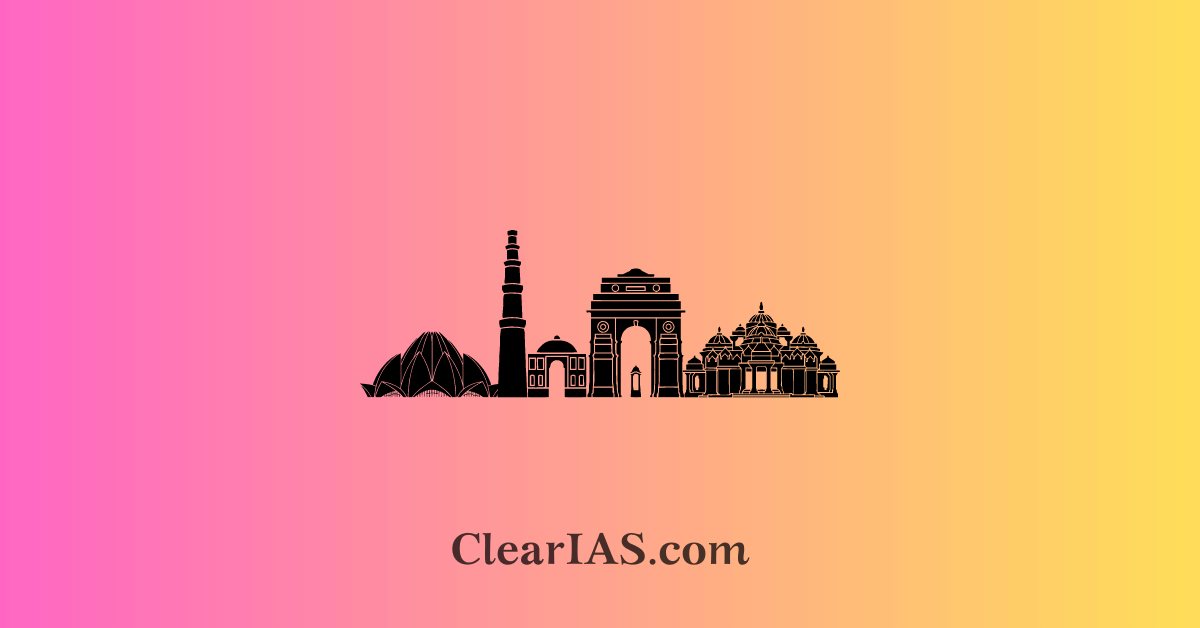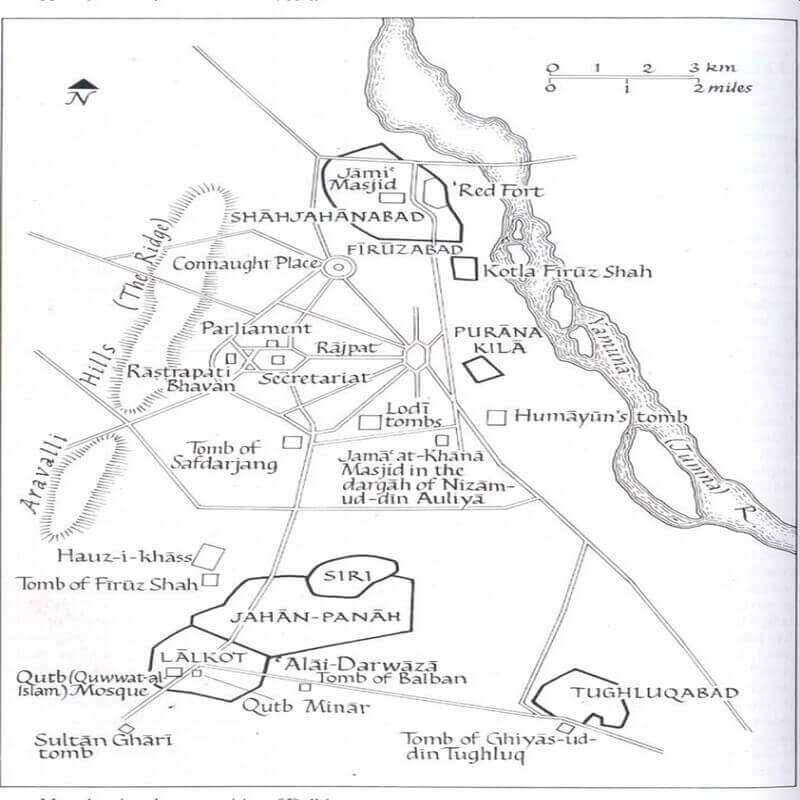
The Cities of Delhi have been settled and resettled several times over the centuries. Delhi has a long history which despite occasional dislocation, has shown a remarkable continuity and has the unique distinction of having been India’s capital longer than any other city. Read here to learn about the several cities of Delhi.
The history of Delhi is a tapestry of various civilizations, empires, and cultures that have left their marks on the city.
Ancient legend has that “He who rules Delhi, rules India”. It has survived all the vicissitudes of time and fortune.
Though it has frequently changed its site, its character, and its name, it has throughout a continuous thread of existence it has seen the rise and fall of many civilizations.
From Indraprastha of Mahabharat to the present New Delhi, it has grown into a mega metropolis. From the Dilli of Raja Dillu to New Delhi, it has always commanded power.
Cities of Delhi
The earliest reference to a settlement at Delhi is found in Mahabharata. King Dhratarshta of Hastinapur have the tracts around Delhi to Pandavas to set up their Kingdom.
- This part of Delhi was known as Khandavaprastha. Yudhisthir, the Pandava prince, cleared the forest known as Khandavavan and established the city, Indraprastha, in Delhi.
- Indeed, it was a formidable city so grand that it made Kauravas the enemies of Pandavas. From that period Delhi witnessed the rise and fall of many dynasties and Empires.
- The location of the city attracted Indian rulers of all kinds from ancient times because of its strategic and commercial value.
It would be easy to argue that the cities of Delhi were in reality less or more than seven. But the accepted number is seven (excluding New Delhi) and these are cities whose remains are extant.
Historians speak of the “Seven Cities of Delhi” but, between 1100 CE and 1947 CE, there have been eight of them:
- Indraprastha- the oldest city
- Siri
- Tughlqabad
- Jahanpanah
- Firozobad
- The city around Purana Qila
- Shahjahanabad
- New Delhi
Each of these cities grew around the palace fortress of a particular dynasty and every dynasty wished to have a new headquarters for consideration of prestige.
- Even the Kings of the same dynasty had these ambitions and realized it if they had the means to do so.
- With each successive reign, some distinctive architectural features were added or some change in urban morphology occurred.
- Often some important new buildings would rise, something monumental – whether a mosque or a tomb, a palace, a fortress, or a victory tower.
The Cities of Delhi in detail

The story of Delhi as the Capital of India began with the Muslim conquest of Northern India at the end of the twelfth century. Since then, with some interludes, it has been the seat of every central political authority.
Delhi has served as the capital of several empires and dynasties, each contributing to its rich historical and cultural heritage.
Indraprastha
According to Hindu mythology, the city of Indraprastha believed to be around the present-day Purana Qila area, was founded by the Pandavas from the epic Mahabharata.
- This city is mentioned in ancient texts like the Mahabharata and the Puranas.
- During the Mauryan period, Indraprastha was known as Indapatta in Buddhist literature.
- The location of Indraprastha is uncertain but Purana Qila in present-day New Delhi is frequently cited.
Qila Rai Pithora
The city of Delhi saw its earliest historical beginnings during the rule of the Rajput Tomar dynasty.
Anangpal Tomar founded Delhi or Lalkot in 1052. A Vikram Samvat 1383 inscription in Delhi Museum confirms the founding of Delhi by the Tomars.
Anangpal Tomar is credited with establishing the city of Lal Kot, later renamed Qila Rai Pithora, around the 11th century.
- The Chauhan kings of Ajmer conquered Lal Kot in 1180 and renamed it Qila Rai Pithora.
- The Chauhan king Prithviraj III was defeated in 1192 by Muhammad Ghori in the Second Battle of Tarain, solidifying Muslim presence in northern India and shattering Rajput power in the Indo-Gangetic Plain.
Siri
The establishment of the Delhi Sultanate marked a significant phase in the city’s history.
The second city of Delhi during the Sultanate period, Siri, was built by Alauddin Khilji and expanded by subsequent rulers. It witnessed major historical events, including the Mongol invasions.
- He constructed Siri between 1297 and 1307 to defend India and Delhi against Mongol raids. The Siri Fort had the appearance of a sizable Turkish castle.
- The majority of buildings built during this period were Seljuk in design. As they fled Mongol incursions, craftsmen from the West Asian Sejuqian dynasty made contributions to the Delhi court’s construction.
- The Hauz Khas reservoir and long lengths of enormous stone walls serve as modern-day representations of the Siri fort.
- The Hazar Sutan, a palace with 1,000 pillars inside the fort, was formerly regarded as the pride of the city. Its Darwaza (door) reportedly has elaborate decorations.
- The eastern part of the remains includes bastions, slits for arrows, and flame-shaped battlements, all of which were considered to be remarkable new features at the time.
- Beyond the fort’s walls, a palace was built with marble floors and other stone accents.
- Local tyrants are blamed for demolishing the fort by stealing its stones, bricks, and other artifacts to use in their buildings.
- Siri provided the materials that Sher Shah Suri, a Pashtun Afghan from Bihar in Eastern India, used to construct his metropolis.
Subsequent rulers expanded the city with other urban centers like Tughlaqabad, Jahanpanah, and Firozabad.
Tughlaqabad
Ghiyas-ud-din Tughlaq founded the fortified city of Tughlaqabad in the 14th century.
It was built with the intent of serving as a power center, but its ambitious construction and subsequent abandonment earned it the moniker “City of the Dead.”
- The hallmark of Tughlaq dynasty structures, sloping rubble-filled city walls, are fortified by circular bastions that can reach heights of up to two stories and are capped by battlemented parapets.
- The walled city included seven rainwater tanks. The fort has a half-hexagonal form.
- Much of the city is currently inaccessible because of the dense thorny vegetation.
Jahanpanah
Mohammad bin Tughlaq (son of Ghiyasudding Tugglaq) established Jahanpanah as his new capital, characterized by its well-planned layout and impressive architecture. Jahanpanah translates as “World’s Refuge.”
Firozabad
Firoz Shah Tughlaq, known for his architectural endeavors, built Firozabad. He was responsible for constructing various monuments, including the famous Firoz Shah Kotla.
- It was built in the second half of the 14th century near the Yamuna River.
- It is a fortified enclosure with high walls that houses palaces, pillared rooms, mosques, a pigeon tower, and a water tank.
- An Ashokan pillar is built on the Palace’s roof. Firuz Shah also restored and repaired the Qutub Minar, the Sultan-e-Garhi Tomb of Nasiruddin Mahmood, and the Hauz Khas.
Shergarh or Purana Qila
Humayun built the city of Dinpanah when he first took over the region from the Tughlaqs. But he was ousted by the Suri Dynasty in the Battle of Chausa and the Battle of Kannauj.
Sher Shah Suri demolished it and renamed it Shergarh or Dilli Sher Shahi. It is known as Purana Qila now.
- The Western Gate is named Bada Darwaza and is flanked by powerful bastions; the Northern Gate is called Talaaqi Darwaza or the Forbidden Gate, and the Southern Gate is called Humayun Darwaza.
The Mughal Empire under Babur captured Delhi in 1526, marking the beginning of Mughal rule. Babur’s successor, Humayun, and later Akbar established themselves in Delhi and Agra.
Shahjahanabad
The most famous Mughal city of Delhi, Shahjahanabad, was founded by Emperor Shah Jahan in the 17th century. It is the site of iconic monuments like the Red Fort and the Jama Masjid.
It is today known as Old Delhi.
New Delhi: Amalgamation of Cities of Delhi
In the mid-19th century, the British East India Company shifted the capital of British India from Calcutta to Delhi, marking the creation of “New Delhi” as the new imperial capital.
After India gained independence in 1947, Delhi was declared the capital of the Republic of India. The city has since grown into a major political, economic, cultural, and educational hub.
Conclusion
Throughout its history, Delhi has witnessed the rise and fall of empires, the construction of grand monuments, and the convergence of diverse cultures. Each phase has left an indelible mark on the city, making it a living testament to India’s rich heritage and historical evolution.
-Article by Swathi Satish






Leave a Reply